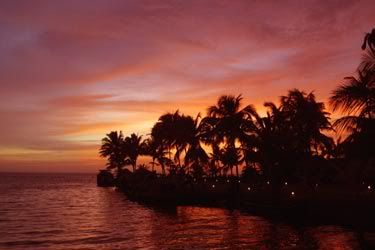Kerala Rain
My grandparents and relations live in the southernmost tip of Kerala, where I spent the first year of my life. The foliage is lush and the air heavy and humid. My grandparents' property is filled with coconut trees and thick prodigious palm leaves, small villages with mortar houses, the largest of which have rectangular openings patterned across them. Honey spouts from makeshift sickles in the trees. In these rural communities, hours from large cities where Western jobs are becoming available, livestock and farming are a huge part of livelihood. My grandmother, nearing 80, cooks and maintains the household and accompanying property with only the help of a few assistants, also seniors. She has a coup of consistently about 20 chickens, which she breeds, skins, cuts and cooks herself. She wakes up every morning before dawn and prays, on her knees, in front of her bed out loud for an hour. Her prayers are so heartfelt that, every single morning, she is in tears by the end. My Malayalam is not very good, so the only words I am ever able to make out are "ende chrithavay"(my god) "stothrum stothrum" (praise, praise.) She'll then sing hymns for about 15 minutes, by which time enough housemembers are awake to join her. The property has about five cows which are milked every morning. When they reach old age, they are sold to a local butcher. These communities are almost entirely self-sustaining, transportation has not been integrated enough for imports from north India, let alone internationally. When students begin toward a career path, they will, with luck, migrate to Bangalore, Hyderabad or Mysore, about 24 hours north by car.

I was pretty sure that no one I know had been effected by Sunday's earthquake. The majority of the damage took place in Madras, about a day away by train. But if it had, aid would be slow and disorganized. Community is cohesive and integrated, and people are willing to help one another out in small towns, but public transportation is nonexistant and automobiles are owned only by professional drivers, career chafeurs who have a community-based clientele in the manner of a barber. My grandparents live about 3 hours away from the shore, far enough away to not have witnessed substantial damage. The incredibly high death rates are related less to the span of the tsunamis, which mostly effected shoreline communities, but population density, which is higher in South Asia than most places in the world. Additionally, they are a jolting reminder of how uneven our global telecommunications infrastructure is. With 2 hours notice, little to no warning was given to the thousands in Sri Lanka, Thailand, and India. The reality is that the majority of these communities lack even the skeleton of a telecommunications infrastructure. Telephones are few and far between; while there may be at least one per village, most of these numbers are not listed in any database. Depending on who you ask, this may change with the introduction of relatively inexpensive wireless access on PC's, which is wheeled onto villages on a rickshaw and requires a small fee. (It should be noted that the most "wired" city, Bangalore, has wireless connections which are almost all privatized.) VOIP, another telecom buzzword, is being hailed by some as the revolutionary technology which will introduce cheap telephone and internet access to third world nations. Some are calling for a state-funded telecommunications infrastructure.

I am glad that Sunday's earthquake and the resulting tsunamis are garnering as much media coverage as it is. I have uncomfortable memories of the American public's reaction to the 2001 earthquake in Gujarat, which claimed 20,000 lives in less than 48 hours, but was cast off the radar of public awareness only weeks later when Dale Earnhart died in a carcrash. There are some complaints about the amount of foreign aid being distributed by United States--currently about $35 million. As many noted, this is the amount of money spent in four hours in Iraq. In this kind of crisis, immediate food and medical aid is useless without aid in transportation and rebuilding. $35 million is a good start, but the proof is in the pudding as to how much more will go into rebuilding infrastructures and communications over the next few years. For now, pledging a strong long-term commitment and developing a long-term aid plan would be appreciated. In the next few years, putting money into cheap wireless infrastructures and establishing a community-based disaster relief plan, enabling South Asians to save themselves as quickly as possible, without waiting for foreign aid, might be wise as well. At 120,000 and counting, this is easily already the biggest tragedy of our lifetimes, and among the most destructive natural disasters in history.
The best place to keep abreast of aid donations is an Indian newspaper called The Hindu. And of course, the Red Cross is the wisest bet for well-dispersed donations.


0 Comments:
Post a Comment
<< Home